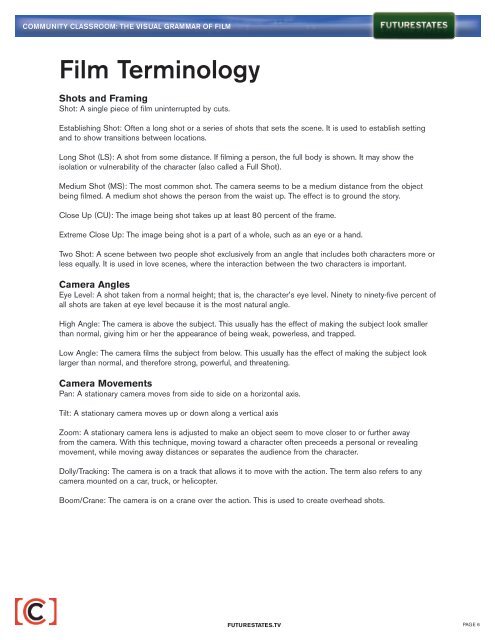Lesson plan - FutureStates
Lesson plan - FutureStates
Lesson plan - FutureStates
You also want an ePaper? Increase the reach of your titles
YUMPU automatically turns print PDFs into web optimized ePapers that Google loves.
COMMUNITY CLASSROOM: THE VISUAL GRAMMAR OF FILM<br />
Film Terminology<br />
Shots and Framing<br />
Shot: A single piece of film uninterrupted by cuts.<br />
Establishing Shot: Often a long shot or a series of shots that sets the scene. It is used to establish setting<br />
and to show transitions between locations.<br />
Long Shot (LS): A shot from some distance. If filming a person, the full body is shown. It may show the<br />
isolation or vulnerability of the character (also called a Full Shot).<br />
Medium Shot (MS): The most common shot. The camera seems to be a medium distance from the object<br />
being filmed. A medium shot shows the person from the waist up. The effect is to ground the story.<br />
Close Up (CU): The image being shot takes up at least 80 percent of the frame.<br />
Extreme Close Up: The image being shot is a part of a whole, such as an eye or a hand.<br />
Two Shot: A scene between two people shot exclusively from an angle that includes both characters more or<br />
less equally. It is used in love scenes, where the interaction between the two characters is important.<br />
Camera Angles<br />
Eye Level: A shot taken from a normal height; that is, the character’s eye level. Ninety to ninety-five percent of<br />
all shots are taken at eye level because it is the most natural angle.<br />
High Angle: The camera is above the subject. This usually has the effect of making the subject look smaller<br />
than normal, giving him or her the appearance of being weak, powerless, and trapped.<br />
Low Angle: The camera films the subject from below. This usually has the effect of making the subject look<br />
larger than normal, and therefore strong, powerful, and threatening.<br />
Camera Movements<br />
Pan: A stationary camera moves from side to side on a horizontal axis.<br />
Tilt: A stationary camera moves up or down along a vertical axis<br />
Zoom: A stationary camera lens is adjusted to make an object seem to move closer to or further away<br />
from the camera. With this technique, moving toward a character often preceeds a personal or revealing<br />
movement, while moving away distances or separates the audience from the character.<br />
Dolly/Tracking: The camera is on a track that allows it to move with the action. The term also refers to any<br />
camera mounted on a car, truck, or helicopter.<br />
Boom/Crane: The camera is on a crane over the action. This is used to create overhead shots.<br />
FUTURESTATES.TV<br />
PAGE 6


